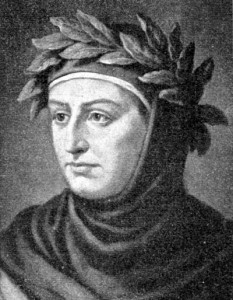 One hundred paintings inspired by the Tales of Boccaccio by Jenny McIntosh, Scottish transplant to Bagni di Lucca, are on exhibit in Lucca at Corte dell’Angelo, via Roma this week beginning on November 5th (see What’s On). Her discov- ery of Boccaccio is a tale within a tale in- volving Franklin Samuel Stych, “Sam” as he is known to all. Humanist scholar and bib- liographer, Sam Stych has been researching Boccaccio for 30 years, and continued even after moving to Bagni di Lucca in 1977.
One hundred paintings inspired by the Tales of Boccaccio by Jenny McIntosh, Scottish transplant to Bagni di Lucca, are on exhibit in Lucca at Corte dell’Angelo, via Roma this week beginning on November 5th (see What’s On). Her discov- ery of Boccaccio is a tale within a tale in- volving Franklin Samuel Stych, “Sam” as he is known to all. Humanist scholar and bib- liographer, Sam Stych has been researching Boccaccio for 30 years, and continued even after moving to Bagni di Lucca in 1977.
Sam’s mind is remarkably sharp despite his age. When we visited him (and Alessio his cat) a few weeks ago he directed Jenny and me to several books from his shelves: his bibliographical work on Boccaccio pub- lished by Greenwood Press, the monograph he authored for the Pinocchio Foundation entitled Pinocchio in England, and his 430-page Ph.D. dissertation for the University of Sheffield on Lucchese novelle by Nicolao Grannucci (1521-1603).
Jenny’s weekly visits to 95-year-old Sam have been an occasion to share a glass of wine while talking about literature, history and life. She learned that the Decameron, a collection of 100 novellas written be- tween 1349 and 1351 – shortly after the plague had decimated Florence and driven many people to country retreats – was sur- prisingly complex in its approach to women. As she read the tales and talked with Sam, she found herself painting her way into the psyches of women like Griselda, Alibech, Madonna Agnesa, Monna Sismonda, Belcolore, and also of the seven women narrators who spent their time swapping tales with their three male companions before returning to their tra- ditional life and roles in Florence.
The countryside, then as now, offers an es- cape from ordained behavior into a bucolic and sometimes barnyard world where codi- fied rules are loosened and natural expres- sion is enhanced. Many of the women in the tales trick and cuckold their husbands. But the Decameron ends with a twist, Boccaccio’s famous story of the “patient Griselda”, a young wife taught to “tow the line” by her older husband Gualtieri, a law- yer. Dioneo, the narrator of this tale, warns his companions, and by extension we the readers, that his tale is descriptive and by no means a prescription for good behavior. Indeed, Gualtieri is not only a misogynist, he is even sadistic in enforcing his moral les- sons of obedience and patience on his wife. Savonarola and the Inquisition, although 150 years in the future, might even come to mind! We are reminded that the young peo- ple are about to return to Florence, their idyll coming to an end.
Sam’s life offers a remote parallel to the Decameron. He and a group of friends working in Florence (headed up by Ian Greenlees, then head of the British Institute) began coming to Bagni di Lucca on weekends, enjoying conversations, wine and a retreat from urbanity. Sam still lives in Via del Bagno, next door to the house of Montaigne – whose plaque reads: “In the summer of 1581, Michel de Montaigne lived in this house for 74 days, and wrote about it in his Journal du voyage”. The Fondazione Michel de Montaigne, estab- lished in 2007, continues to promote cul- tural initiatives in Bagni di Lucca.
1 Comment
Boccaccio’s Man | From London to Longoio (and Lucca and beyond) Part One · at
[…] Boccaccio in English: a bibliography of editions, adaptations, and criticism. Sam devoted twenty years of his retirement here in Bagni di Lucca to the creation of a comprehensive annotated bibliography of 2,242 items by Boccaccio, adapted from Boccaccio, or about Boccaccio. His material was edited and prepared for publication by his former student, Michael Buckland, at the School of Information Management and Systems. This seminal work remains the most formidable tool for any research on Boccaccio. It has also inspired another of Sam’s friends, the Scottish artist and resident of Bagni di Lucca Jenny McIntosh, to present one of her most memorable exhibitions, “Boccaccio’s Women”, in Lucca in November 2011. (See http://www.planningatour.com/2011/11/boccaccio%E2%80%99s-women/) […]